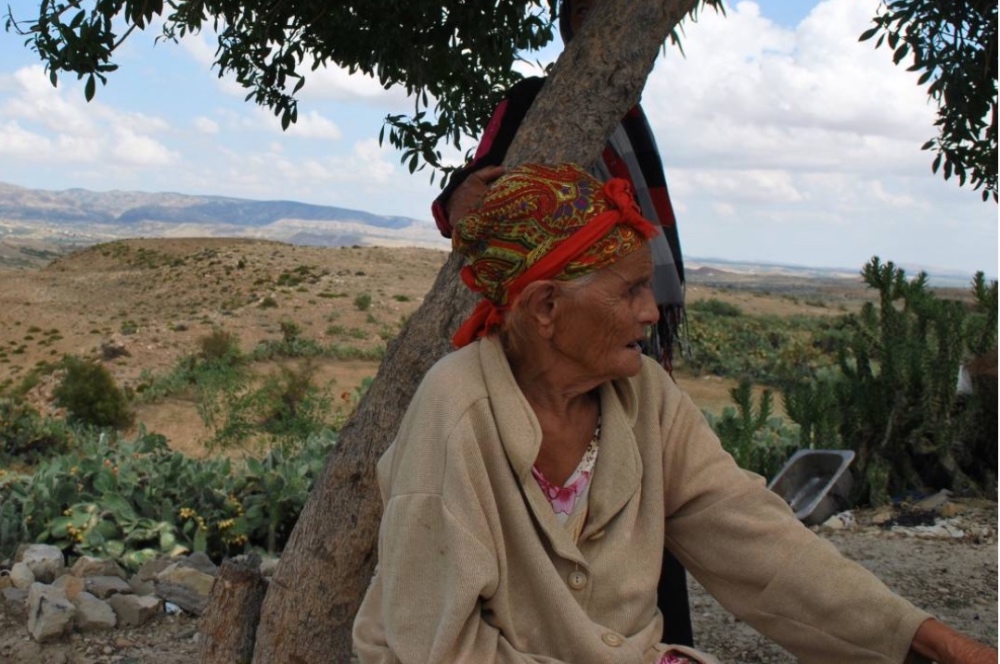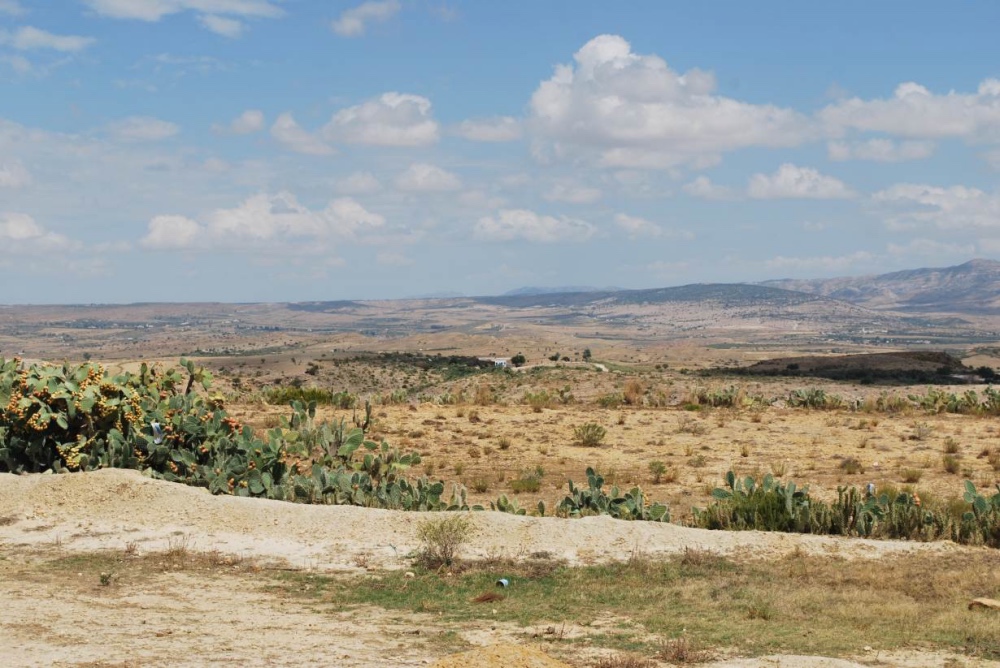
LAYLI FOROUDI, of Thomson Reuters Foundation, reports…
Kairouan, Tunisia
Thomson Reuters Foundation
If pushed to sacrifice showering, cooking, drinking or raising his chickens, Tunisian farmer Saeed Barhoumi said he would first forgo showering. It is a decision that he and his family frequently face.
The closest source of clean water is a collective tap that is a four kilometre walk away from their isolated home on an arid plain in the northern region of Kairouan.
No pipes or roads run to their house and they are not serviced by the volunteer-run collectives, known as Agricultural Development Groups, who are tasked with bringing water from wells to more than half the region’s inhabitants.
“We used to grow much more wheat, we used to plant tomatoes, but we don’t have [enough] water,” said Barhoumi, overlooking the dusty hills stretching out in front of his doorstep.

Grandmother Massouda Barhoumi sits under a tree on her family’s land, which is a four kilometre walk from the nearest source of water in the centra; region of Kairouan, Tunisia, on 2nd Sepetmber. PICTURE: Layli Foroudi/Thomson Reuters Foundation.
Poor planning, sparse water resources and the worsening impacts of climate change have combined to create a crippling water crisis in Tunisia, say civil society groups.
In 2018 more than 94 per cent of Tunisians had access to water, either through the national supplier or the GDA, according to official figures.
“We used to grow much more wheat, we used to plant tomatoes, but we don’t have [enough] water.”
– Tunisian farmer Saeed Barhoumi
But Alaa Marzougui, coordinator at the non-governmental organisation Nomad08 for socio-economic and cultural rights, estimates the real number is significantly lower.
Due to random cuts to water supplies, debt and management issues with the GDAs and the poor quality of water that runs from the taps, Marzougui said about three-quarters of the population have problems accessing clean water.
Data from the ministry of agriculture shows the total amount of water available in the country can provide 420 cubic metres per person per year, making it a “very water scarce country”, by UN Water standards.
The country’s irregular rainfall patterns are accentuated by climate change, with periods of droughts and record high temperatures oscillating between torrential rain and floods, according to the agriculture ministry.
The latest government figures also reveal that poor infrastructure means in some regions about half of water is lost before it even reaches the tap.
“We monopolise more than 90 per cent of our water – what we have we are already using,” said Imen Louati, research officer at the non-governmental Tunisian Economic Observatory (OTE).
In Kairouan, water drains a quarter of the Barhoumi family’s monthly budget. Eleven plastic cylinders of varying heights sit in their courtyard, storing water for use by 11 people, as well as a small wheat crop and some chickens.
It is mostly women who carry the burden of fetching water, said Minyara Mejbri, regional coordinator of the Tunisian Forum for Economic and Social Rights in Kairouan.
“They might spend the whole day working in the field, then prepare dinner, then take the container to the communal tap, where they often have to queue for one hour,” she said.
In 2015, Barhoumi’s nine-year-old daughter Ahlem killed herself, a tragedy that the family puts down to the remoteness of their home and the lack of resources, including water.
“She dreamt of another life, to live near her school,” said her grandmother, Massouda, who had walked with Ahlem to collect 20 litres of rainwater that day.
“Here, she has no shower, no friends, all her dreams are elsewhere.”

Kairouan in Tunisia, is an intensive farming region where thirsty crops like watermelon are grown and groundwater resources are exploited. Photo taken on 2nd September. PICTURE: Thomson Reuters Foundation/Layli Foroudi
Even for houses on the grid, water is not guaranteed. Nomad08 recorded 3,000 cuts between 2016 and 2018 across the country, lasting up to 60 days at a time.
During the Eid al-Adha holiday in August, as families gathered in the scorching heat to feast and celebrate, many regions experienced cuts to their water supply for three days, sparking protests and road blockages.
“It is annoying, but we’re used to it now,” said Lamia Smaine Dhib, a housewife on a farm in Kelibia, one of the towns affected.
“We need a lot of water during Eid – for cooking, showering, for washing the intestines of the sheep,” she said, referring to the traditional method for preparing meat during the holiday.
“The infrastructure is bad, we lose water in the distribution network. The summer months are peak tourist season, so there is a lot of water consumption,” said Louati of the OTE.
“And because of climate change, the availability of water varies more than before.”
In 2017, the Minister of Agriculture created a committee dedicated to prioritising climate change in the management of agriculture and water.
“We are in front of a fait accompli – we need to do with what we have and it is only going to become less [water],” said Rafik Aini, coordinator of the committee and senior negotiator in climate change at the agriculture ministry.
Tunisia’s new Water Code, which was approved by ministers in September and is waiting to be debated by parliament, includes climate change as a factor to be considered in water policy decisions, unlike the original 1975 code.
“The infrastructure is bad, we lose water in the distribution network. The summer months are peak tourist season, so there is a lot of water consumption. And because of climate change, the availability of water varies more than before.”
– Imen Louati, research officer at the non-governmental Tunisian Economic Observatory.
In addition to repairing the water network, Aini told the Thomson Reuters Foundation that the government’s 2050 strategy for water will involve desalination projects powered by renewable energy.
But desalination, which removes salt from both sea-water and groundwater, “does not solve the problem”, said Tunisian water expert Raoudha Gafrej.
“It costs a lot of money and there is still [more] water lost through the network [than desalination stations are projected to produce].”
There is also an environmental cost. In January, a study by the UN University Institute for Water, Environment and Health warned that the global levels of surplus salty brine produced by this method were 50 per cent higher than previous estimates.
Desalination would also have “profound impacts” on the sea ecosystem, where this waste is mostly dumped, the report found.
In tackling Tunisia’s water crisis, the “politics of agriculture needs to change,” said Gafrej. “With precious and rare water, we do not have the right to produce certain cultures like watermelons.”
Currently, about 80 per cent of Tunisia’s natural water resources are used for agriculture, according to last year’s government figures. Thirsty crops like oranges, watermelons and tomatoes are grown for export abroad, mostly to Europe.
In intensive farming regions, like Kairouan, groundwater is being extracted at a faster rate than the underground supply is renewed, as well as from non-renewable groundwater sources.
A government report noted that these resources are exploited up to 400 per cent in certain regions.
Aini agreed that decisions about what crops should be grown are important but “this is for the new government [elected on 6th October] to decide.”
For Marzougui from Nomad08, it is one of several decisions about how Tunisia uses water that are becoming more urgent by the day.
“We export almost everything and with very little added value,” he said.
“Even if we have the water [for now], we need to think about the future generation and sustainability.”





